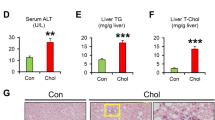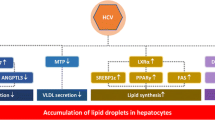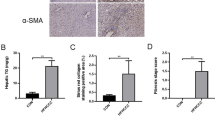Abstract
Objective
The relationship between chronic hepatitis B virus (HBV) infection and fatty liver in patients remains unclear. Although high-fat diets-induced hepatic steatosis was proved to reduce HBV replication in transgenic mice, the interplay between HBV and fatty liver in immunocompetent mouse model is yet to be elucidated. Here, we aimed to develop an effective animal model for intracellular HBV persistence combined with hepatic steatosis and to explore their interactions.
Methods
FVB/N mice with HBV genotype B replicon DNA were established by hydrodynamic injection. Mice injected with HBV or control plasmid vectors were then randomized into NAFLD + HBV, HBV, NAFLD, and control groups and treated with a high-fat or standard diet for up to 14 weeks. The characteristics of NAFLD were evaluated by physical indices, liver function tests, glycolipid metabolism, and liver histopathological changes. Viral dynamics were also analyzed by HBV DNA and HBV-related antigens.
Results
HBV clone persistently replicated in the livers of FVB/N mice, and hepatic steatosis was induced by a high-fat diet. The NAFLD and NAFLD + HBV groups shared similar physical features, glycolipid metabolism, liver function, and hepatic steatosis. Serum hepatitis B e antigen (HBeAg), hepatic hepatitis B s antigen (HBsAg),hepatitis B c antigen (HBcAg), and HBV DNA were decreased in the NAFLD + HBV group compared with those in the HBV group at the end of 14 weeks.
Conclusion
In an HBV-immunocompetent mouse model, non-alcoholic hepatic steatosis inhibited HBV replication, as indicated by the reduction of HBV DNA and HBV-related antigens. HBV replication did not alter lipid metabolism in mice.




Similar content being viewed by others
References
Mortality GBD, Causes of Death C. Global, regional, and national age-sex specific all-cause and cause-specific mortality for 240 causes of death, 1990–2013: a systematic analysis for the Global Burden of Disease Study 2013. Lancet 2015;385:117–171
Schweitzer A, Horn J, Mikolajczyk RT, Krause G, Ott JJ. Estimations of worldwide prevalence of chronic hepatitis B virus infection: a systematic review of data published between 1965 and 2013. Lancet 2015;386:1546–1555
Williams CD, Stengel J, Asike MI, Torres DM, Shaw J, Contreras M, et al. Prevalence of nonalcoholic fatty liver disease and nonalcoholic steatohepatitis among a largely middle-aged population utilizing ultrasound and liver biopsy: a prospective study. Gastroenterology 2011;140:124–131
Wong VW, Wong GL, Choi PC, Chan AW, Li MK, Chan HY, et al. Disease progression of non-alcoholic fatty liver disease: a prospective study with paired liver biopsies at 3 years. Gut 2010;59:969–974
Asselah T, Rubbia-Brandt L, Marcellin P, Negro F. Steatosis in chronic hepatitis C: why does it really matter? Gut 2006;55:123–130
Cheng YL, Wang YJ, Kao WY, Chen PH, Huo TI, Huang YH, et al. Inverse association between hepatitis B virus infection and fatty liver disease: a large-scale study in populations seeking for check-up. PLoS One 2013;8:e72049
Wong GL, Wong VW, Choi PC, Chan AW, Chim AM, Yiu KK, et al. Metabolic syndrome increases the risk of liver cirrhosis in chronic hepatitis B. Gut 2009;58:111–117
Chan AW, Wong GL, Chan HY, Tong JH, Yu YH, Choi PC, et al. Concurrent fatty liver increases risk of hepatocellular carcinoma among patients with chronic hepatitis B. J Gastroenterol Hepatol 2017;32:667–676
Jin X, Chen YP, Yang YD, Li YM, Zheng L, Xu CQ. Association between hepatic steatosis and entecavir treatment failure in Chinese patients with chronic hepatitis B. PLoS One 2012;7:e34198
Ates F, Yalniz M, Alan S. Impact of liver steatosis on response to pegylated interferon therapy in patients with chronic hepatitis B. World J Gastroenterol 2011;17:4517–4522
Chu CM, Lin DY, Liaw YF. Does increased body mass index with hepatic steatosis contribute to seroclearance of hepatitis B virus (HBV) surface antigen in chronic HBV infection? Int J Obes (Lond) 2007;31:871–875
Chu CM, Lin DY, Liaw YF. Clinical and virological characteristics post HBsAg seroclearance in hepatitis B virus carriers with hepatic steatosis versus those without. Dig Dis Sci 2013;58:275–281
Machado MV, Oliveira AG, Cortez-Pinto H. Hepatic steatosis in hepatitis B virus infected patients: meta-analysis of risk factors and comparison with hepatitis C infected patients. J Gastroenterol Hepatol 2011;26:1361–1367
Ceylan B, Arslan F, Batirel A, Fincanci M, Yardimci C, Fersan E, et al. Impact of fatty liver on hepatitis B virus replication and virologic response to tenofovir and entecavir. Turk J Gastroenterol 2016;27:42–46.
Lesmana LA, Lesmana CR, Pakasi LS, Krisnuhoni E. Prevalence of hepatic steatosis in chronic hepatitis B patients and its association with disease severity. Acta Med Indones 2012;44:35–39
Wong VW, Wong GL, Chu WC, Chim AM, Ong A, Yeung DK, et al. Hepatitis B virus infection and fatty liver in the general population. J Hepatol 2012;56:533–540
Joo EJ, Chang Y, Yeom JS, Ryu S. Hepatitis B virus infection and decreased risk of nonalcoholic fatty liver disease: A cohort study. Hepatology 2017;65:828–835
Dembek C, Protzer U. Mouse models for therapeutic vaccination against hepatitis B virus. Med Microbiol Immunol 2015;204:95–102
Zheng Y, Chen WL, Louie SG, Yen TS, Ou JH. Hepatitis B virus promotes hepatocarcinogenesis in transgenic mice. Hepatology 2007;45:16–21
Cobleigh MA, Wei X, Robek MD. A vesicular stomatitis virus-based therapeutic vaccine generates a functional CD8 T cell response to hepatitis B virus in transgenic mice. J Virol 2013;87:2969–2973
Chen SH, Wu HL, Kao JH, Hwang LH. Persistent hepatitis B viral replication in a FVB/N mouse model: impact of host and viral factors. PLoS One 2012;7:e36984
Kim KH, Shin HJ, Kim K, Choi HM, Rhee SH, Moon HB, et al. Hepatitis B virus X protein induces hepatic steatosis via transcriptional activation of SREBP1 and PPARgamma. Gastroenterology 2007;132:1955–1967.
Kim K, Kim KH, Kim HH, Cheong J. Hepatitis B virus X protein induces lipogenic transcription factor SREBP1 and fatty acid synthase through the activation of nuclear receptor LXRalpha. Biochem J 2008;416:219–230
Wu YL, Peng XE, Zhu YB, Yan XL, Chen WN, Lin X. Hepatitis B virus X protein induces hepatic steatosis by enhancing the expression of liver fatty acid binding protein. J Virol 2015;90:1729–1740
Li YJ, Zhu P, Liang Y, Yin WG, Xiao JH. Hepatitis B virus induces expression of cholesterol metabolism-related genes via TLR2 in HepG2 cells. World J Gastroenterol 2013;19:2262–2269
Shi JP, Fan JG, Wu R, Gao XQ, Zhang L, Wang H, et al. Prevalence and risk factors of hepatic steatosis and its impact on liver injury in Chinese patients with chronic hepatitis B infection. J Gastroenterol Hepatol 2008;23:1419–1425
Peng D, Han Y, Ding H, Wei L. Hepatic steatosis in chronic hepatitis B patients is associated with metabolic factors more than viral factors. J Gastroenterol Hepatol 2008;23:1082–1088
Zheng RD, Chen JN, Zhuang QY, Lu YH, Chen J, Chen BF. Clinical and virological characteristics of chronic hepatitis B patients with hepatic steatosis. Int J Med Sci 2013;10:641–646
Wang CC, Hsu CS, Liu CJ, Kao JH, Chen DS. Association of chronic hepatitis B virus infection with insulin resistance and hepatic steatosis. J Gastroenterol Hepatol 2008;23:779–782.
Acknowledgements
The authors express their gratitude to Prof. Chen PJ (Department of Internal Medicine, National Taiwan University Hospital) for the kind gift of the HBV1.3-B6 plasmid.
Funding
This study was supported by the National Natural Science Foundation of China NSFC Grants (81571989, 81100282, 81500452), Program for Innovative Research Team of Chinese Ministry of Education (IRT-14R20) and National Science and Technology Major Project (2017ZX10202201).
Author information
Authors and Affiliations
Corresponding authors
Ethics declarations
Conflict of interest
Danqing Hu, Hongwu Wang, Hai Wang, Yaqi Wang, Xiaoyang Wan, Weiming Yan, Xiaoping Luo, and Qin Ning declare that they have no competing interests.
Animal study
All experiments were performed using procedures approved by the Huazhong University Institutional Animal Care and Use Committee.
Rights and permissions
About this article
Cite this article
Hu, D., Wang, H., Wang, H. et al. Non-alcoholic hepatic steatosis attenuates hepatitis B virus replication in an HBV-immunocompetent mouse model. Hepatol Int 12, 438–446 (2018). https://doi.org/10.1007/s12072-018-9877-7
Received:
Accepted:
Published:
Issue Date:
DOI: https://doi.org/10.1007/s12072-018-9877-7




